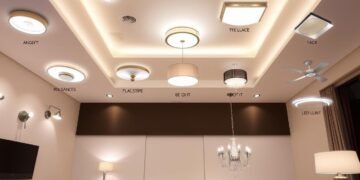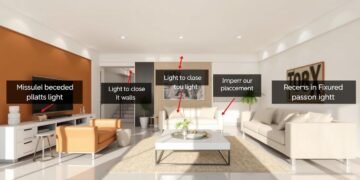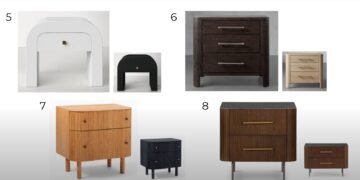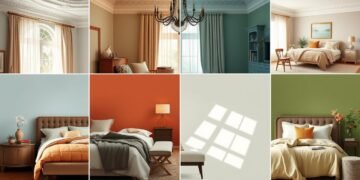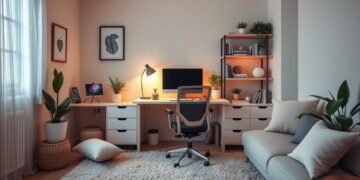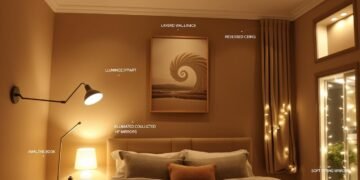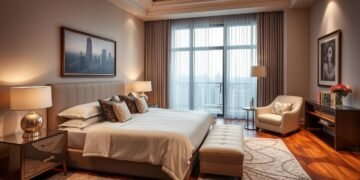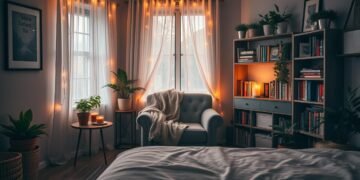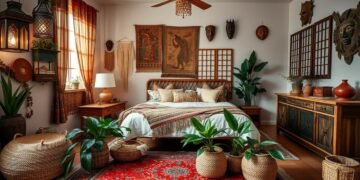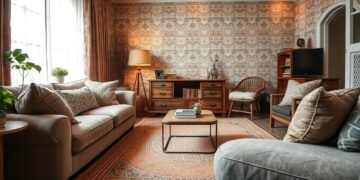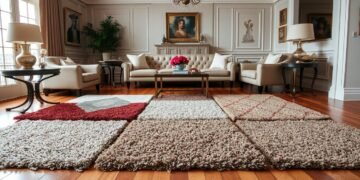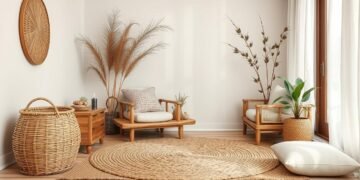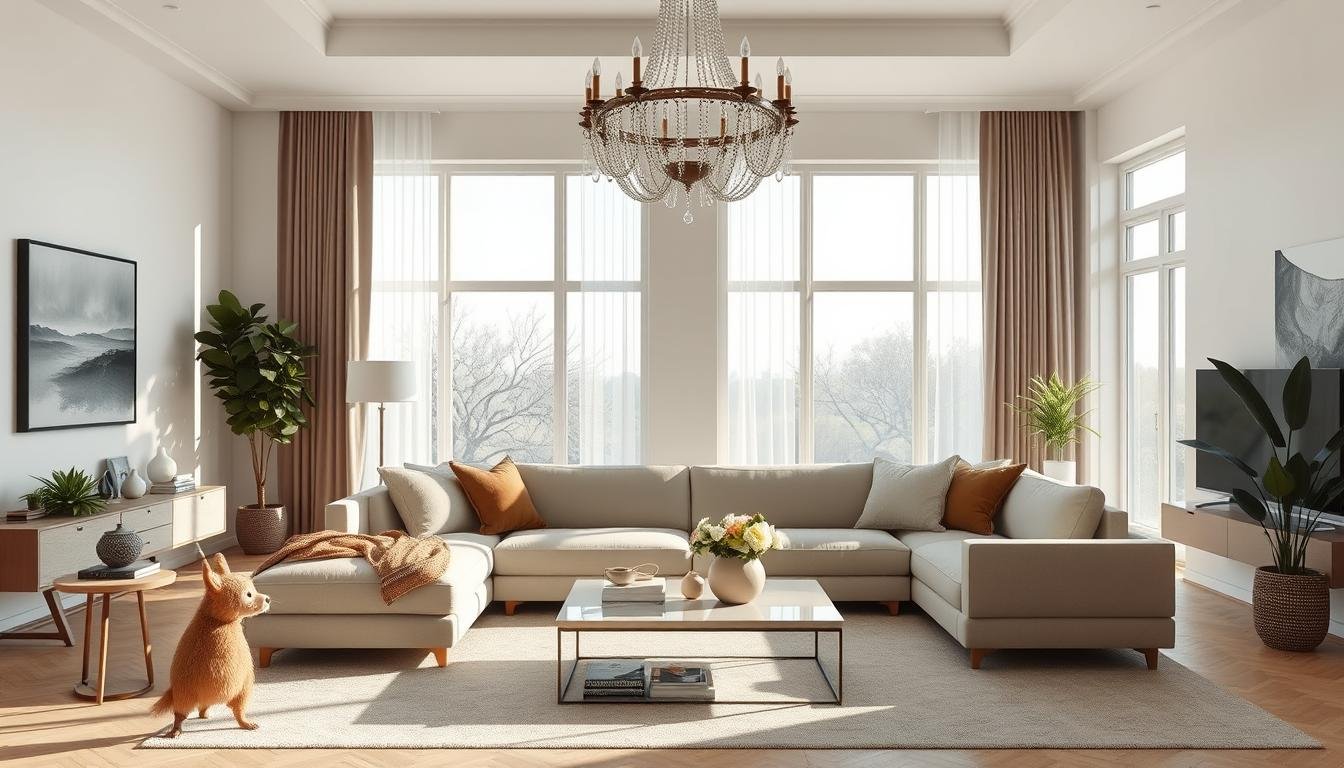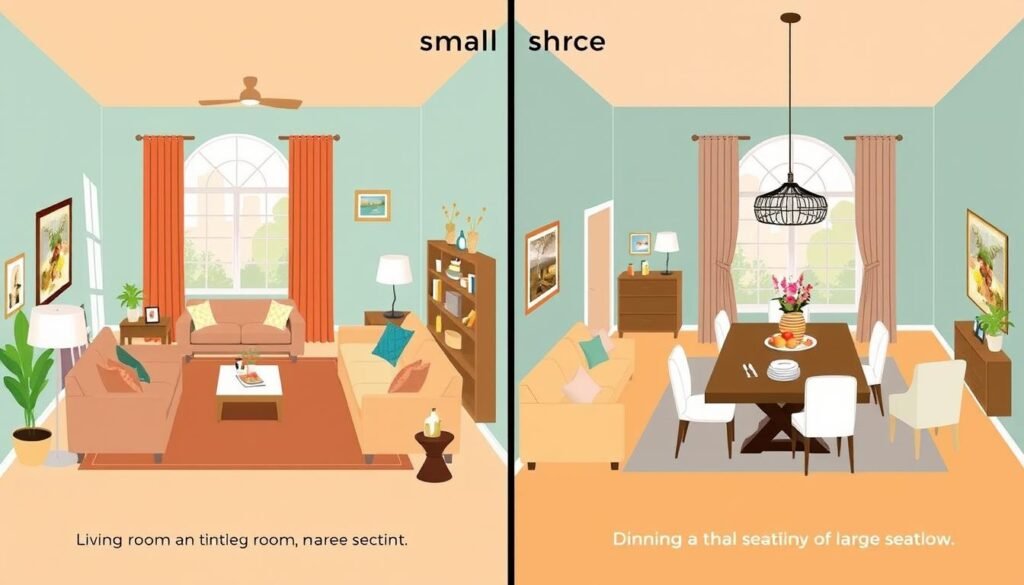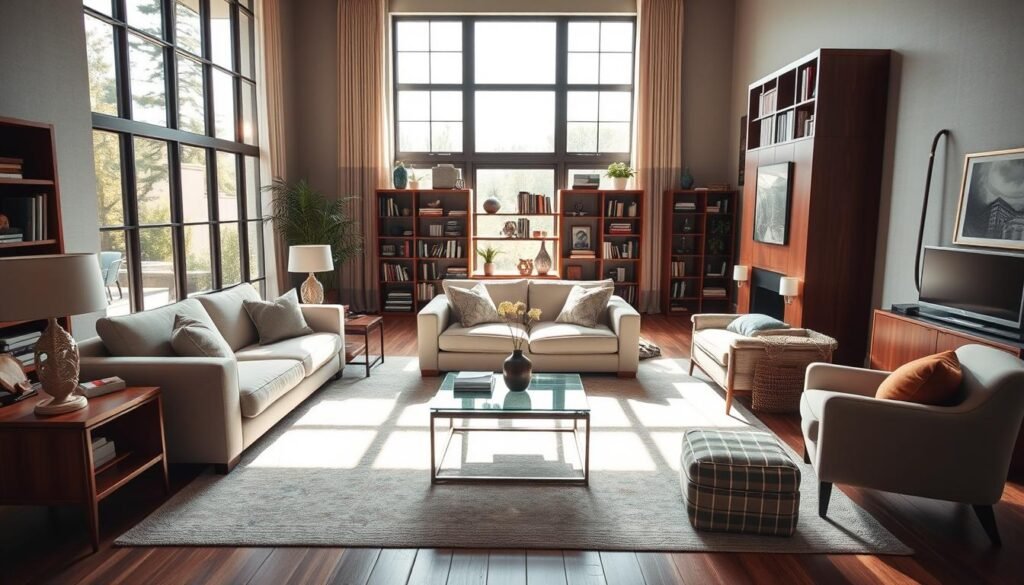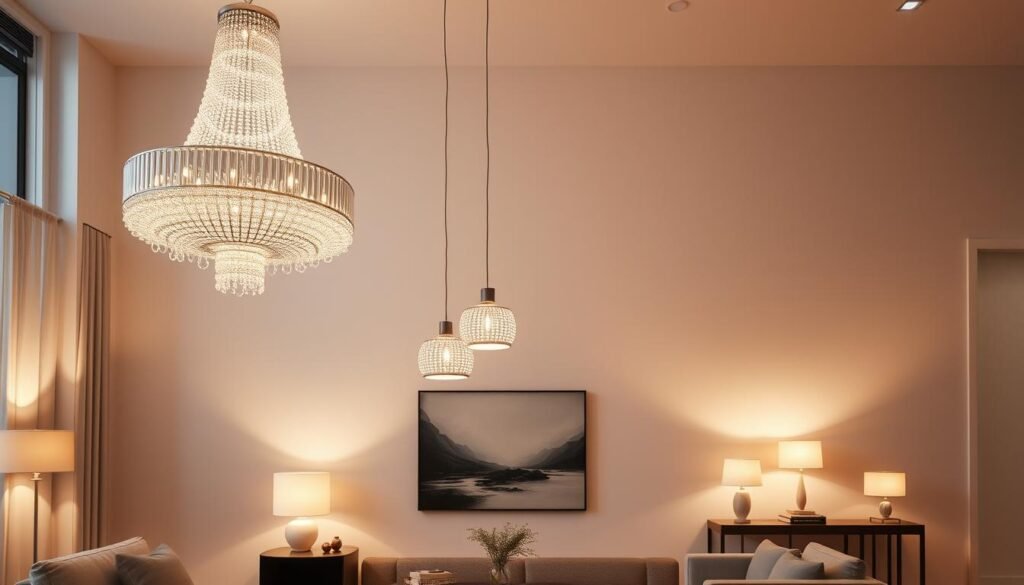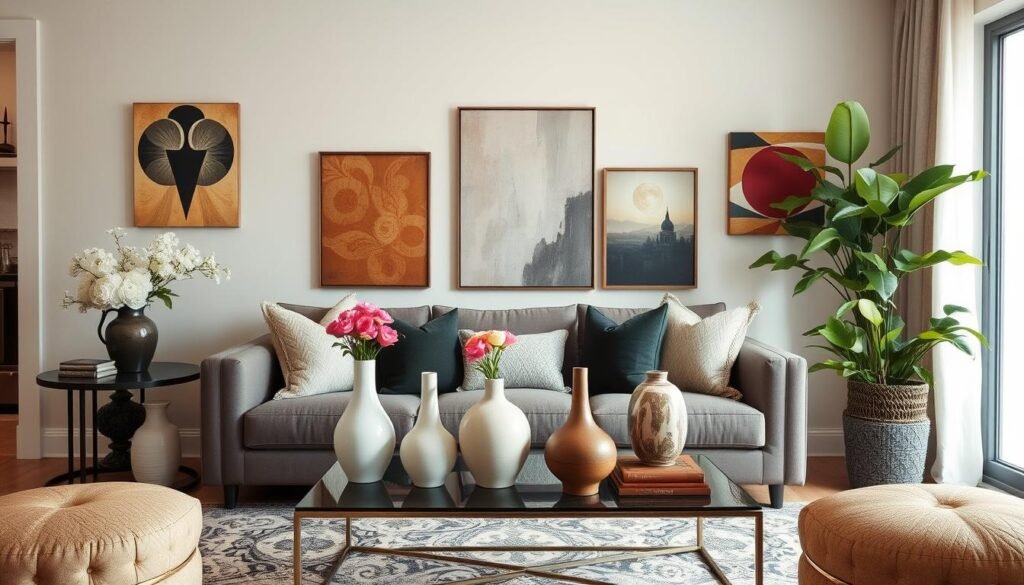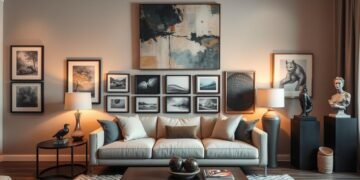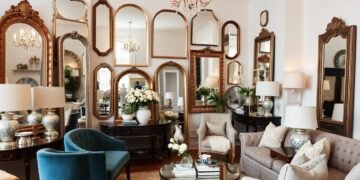I love interior design and know how hard it is to make a space look good and work well. Scale is key, balancing furniture, accessories, and room size. Getting scale right is essential, but many people make common mistakes.
In this guide, we’ll look at 5 common scale mistakes in interior design. We’ll give you tips to fix these issues and make your space perfect. Whether it’s a small living room or a big master suite, understanding scale will make your home reflect your style and be more livable.
Table of Contents
- 1 Understanding Scale and Its Importance in Design
- 1.1 The Fundamental Role of Scale in Interior Design
- 1.2 Relatedarticles
- 1.3 8 Approaches to Choosing the Perfect Focal Point for Any Room
- 1.4 7 Rules for Placing Artwork at the Right Height and Scale
- 1.5 8 Tips for Using Mirrors to Enhance Proportion and Focus
- 1.6 How Scale Affects Visual Balance
- 1.7 The Relationship Between Scale and Room Function
- 2 Scale Mistakes in Home Décor
- 3 The Impact of Improper Scale on Room Flow
- 4 Common Issues with Furniture Proportions
- 5 Lighting and Scale: Finding the Right Balance
- 6 Wall Art and Decorative Elements
- 7 The Role of Ceiling Height in Scale Decisions
- 8 Rug Sizing and Placement Errors
- 9 Window Treatment Scale Considerations
- 10 Scale Solutions for Different Room Types
- 11 Conclusion
- 12 FAQ
- 12.1 What are the common scale mistakes in home décor?
- 12.2 How does improper scale impact room flow?
- 12.3 What are the common issues with furniture proportions?
- 12.4 How does lighting scale affect the visual balance of a room?
- 12.5 How important is the scale of wall art and decorative elements?
- 12.6 How does ceiling height impact scale decisions in interior design?
- 12.7 What are the common mistakes in rug sizing and placement?
- 12.8 How does window treatment scale affect a room’s overall appearance?
- 12.9 How do scale considerations differ for different room types?
- 13 Source Links
Key Takeaways
- Understanding the fundamental role of scale in interior design
- Recognizing how scale affects visual balance and room function
- Identifying common scale mistakes in home décor and furniture selection
- Implementing strategies to create balanced pathways and optimize traffic flow
- Mastering the art of lighting and wall art scale to enhance the overall design
Understanding Scale and Its Importance in Design
Scale is key in interior design. It impacts how a space looks, feels, and works. Knowing how room size, features, furniture, and decor relate helps create spaces that are both beautiful and functional.
The Fundamental Role of Scale in Interior Design
Variety in scale is vital. Rooms need big, medium, and small items to keep things interesting. Furniture should match its purpose, like a coffee table that fits everyone.
Architectural elements, like board and batten, also play a role. Using wainscoting up two-thirds of a wall helps balance furniture and decor.
How Scale Affects Visual Balance
When choosing furniture, aim for similar sizes, not exact matches. This helps maintain balance. Think about the room’s features when picking furniture, like using low pieces for low ceilings and tall items for high ones.
For dining areas, leave 36 inches between the table and walls for easy chair movement. Choose chair styles that flow well together. And, make sure all seating is at the same height for better conversation.
The Relationship Between Scale and Room Function
Vertical scale is important for rooms with high ceilings. Adding tall objects like shelves or artwork helps balance the space. In small rooms, using height, like tall headboards or ceiling-high curtains, makes the room seem bigger.
The Golden Ratio, about 1:1.618, guides scale and proportion in design. It helps create spaces that look balanced and pleasing to the eye.
“Balancing patterns and colors in a room is also important for maintaining scale and proportion in design.”
Scale Mistakes in Home Décor
Getting the scale right in home décor is key to a beautiful and useful space. Yet, many people and designers make common scale mistakes. These mistakes can make rooms look cluttered or empty, disrupt flow, and throw off balance.
One big mistake is picking oversized furniture because you’re worried it’s too small. On the flip side, undersized furniture can also be a problem, as big rooms can handle bigger pieces. The main piece in a room sets the scale for everything else. And, rooms with high ceilings can handle bigger furniture without losing balance.
Another mistake is ignoring space planning and room flow. Leaving some parts of a room empty can stop it from feeling too full. Mixing different fabric sizes can also prevent a room from feeling too heavy. Plus, make sure the height of an item doesn’t go over 13 times the height of what it sits on.
| Mistake | Recommendation |
|---|---|
| Oversized furniture | Choose furniture proportional to the room size |
| Undersized furniture | Select larger pieces to maintain scale and balance |
| Cluttered or sparse-looking rooms | Incorporate negative space and mix pattern sizes |
| Disruptive traffic flow | Plan the room layout and pathways carefully |
| Visual imbalance | Apply the 60-30-10 rule and the golden ratio |
By knowing and avoiding these scale mistakes, we can make our interiors look better. This improves the room flow and visual weight of our spaces.
“Proportion in interior design is maintained by ensuring that the height of an item does not exceed 13 times that of the item it rests upon, contributing to a balanced look.”
The Impact of Improper Scale on Room Flow
Room layout challenges can really affect how well your spaces work. If scale isn’t right, it can mess up how people move around. It’s important to match your room size and furniture to keep things flowing smoothly.
Assessment of Traffic Patterns
First, look at how people move in your room. Notice any spots that are hard to get through or feel too crowded. Big furniture or things placed wrong can block the way, making your space feel cramped.
Creating Balanced Pathways
To fix these issues, make sure there are clear paths. Move furniture to give people room to walk. Try different sizes and places for furniture to find the perfect balance. This way, you can move easily without losing the room’s look.
Space Planning Solutions
Good space planning helps avoid scale problems. Measure your room and think about what you want to do there. This helps pick the right furniture and arrange it for better flow and use. By solving these planning issues, you can make a space that’s easy to move around in.
| Common Room Layout Challenges | Solutions |
|---|---|
| Oversized furniture in small spaces | Choose furniture proportional to the room size and arrange it to allow for clear pathways |
| Undersized furniture in large rooms | Select appropriately scaled pieces and arrange them to create a balanced, harmonious flow |
| Cluttered or disorganized layouts | Streamline the arrangement, prioritize functionality, and ensure smooth traffic patterns |
By tackling room layout problems and planning spaces well, you can make your rooms better. Paying attention to scale and size makes your space more welcoming and nice to look at.
Common Issues with Furniture Proportions
Getting the right furniture to room ratio is key for a balanced look. Many people pick furniture that’s too big or too small. This can make a room feel cramped or empty.
In small spaces, big sofas or armchairs can make it feel too full. On the other hand, small furniture in big rooms can make them seem unused. It’s important to balance the sizes of furniture to keep the room looking good.
For example, art above a bed should cover half to two-thirds of the space. A chandelier over a dining table should be at least half as wide as the table. To pick the right size for an overhead light, add the room’s length and width in feet.
| Furniture Scale Guideline | Ideal Ratio |
|---|---|
| Art above furniture | 1/2 to 2/3 of the space |
| Chandelier above dining table | At least half the width of the table |
| Overhead light fixture diameter | Sum of room length and width in feet |
Choosing furniture that fits well together is vital for a nice look. Furniture that’s the right size makes a room work better and look nicer. It adds harmony and balance, making the space feel thoughtful and well-planned.
Lighting and Scale: Finding the Right Balance
Lighting fixtures are key to a room’s look and feel. A big chandelier, sleek pendant lights, or a cozy table lamp can change a room’s style. The size and look of your lights are very important.
Chandelier and Pendant Sizing Guide
Think about the room’s size and ceiling height when picking lights. A chandelier should be half to two-thirds the room’s width. For tall ceilings, choose a bigger light to keep things balanced.
The light should add to the room’s feel, not take over. It should make the space look better, not worse.
Table Lamp Proportions
Table lamps should match the furniture they sit on. A lamp that’s too small looks odd, while a big one can take over. Aim for a lamp that’s two-thirds the table’s height and a shade that’s two-thirds the table’s width.
Natural Light Considerations
Natural light affects how furniture and decor look in a room. Rooms with lots of natural light can handle bigger pieces. But rooms with little natural light might need lighter, smaller items to keep things balanced.
Choosing the right lighting size and style is key to a nice room. It’s all about lighting fixtures size, lighting proportions, and mixing natural and artificial lighting. If you’re not sure, get help from a pro interior designer.
Wall Art and Decorative Elements
Interior design is all about the right balance of wall art and decor. The scale and placement of these elements can make or break a room’s look. It’s key to create a space that looks good and feels right.
Many people hang small art on big walls or use big pieces in small rooms. The scale of art should match the room and furniture. A big canvas can fill a large wall, while small pieces can add charm to a small space.
The proportions of sculptures and decorative accessories matter too. A standout piece can be a focal point. But, grouping smaller items can make a bigger impact. Each piece should add to the design, not just sit there.
When placing decorative accessories, think about their size and how they fit with the room. Don’t put two similar items together. It looks static. Mix up shapes, sizes, and directions to keep the room interesting.
By focusing on the scale of decor accessories and using them wisely, you can improve your living space. You’ll create a room that’s not only beautiful but also welcoming.
The Role of Ceiling Height in Scale Decisions
The height of your ceiling is key when picking the right scale for your interior design. High ceilings let you fill the vertical space, making the room look balanced and harmonious. Choose taller furniture and bigger decor to match the room’s high ceiling.
Adapting Furniture to Room Height
In rooms with high ceilings, tall bookcases, floor-to-ceiling curtains, and grand chandeliers can balance the space. But, in rooms with low ceilings, smaller furniture is better to avoid a cramped feel. It’s important to think about the size and weight of your furniture in relation to the ceiling.
Vertical Space Utilization
Using the vertical space in your room can change how it looks. Add tall shelves, hanging plants, or wall art to make the room feel bigger. Arranging your decor to use the room’s height can make your space look harmonious and well-proportioned.
| Ceiling Height | Furniture Recommendations | Decor Suggestions |
|---|---|---|
| High Ceilings |
|
|
| Low Ceilings |
|
|
Think about the ceiling height, vertical space, and room dimensions when choosing your furniture and decor. This careful planning will help you create a balanced and visually appealing space. It will also match well with your room’s architecture.
Rug Sizing and Placement Errors
Choosing the right rug size and placement is key to a balanced home. Many people make mistakes that mess up a room’s look. These errors can make a space feel off-balance and disorganized.
A common mistake is picking a rug that’s too small. A tiny rug can make a room look disjointed. It should be big enough to fit around the furniture, leaving 8-12 inches of space.
But, a rug that’s too big can also be a problem. It can make a room feel too full. When picking a rug, think about your room’s size and your furniture. A good rule is to let 1-2 feet of floor show around the rug’s edges in a standard room.
| Room Size | Recommended Rug Size |
|---|---|
| 12 x 12 feet | 10 x 10 feet |
| 14 x 16 feet | 8 x 10 feet |
| 16 x 20 feet | 9 x 12 feet |
In dining rooms, the rug should go beyond the chairs when they’re pulled out. This makes it easier to move around and defines the dining area. For bedrooms, a big rug under the bed works well, leaving space on the sides and at the foot.
By focusing on the right rug size and where to put it, you can make your room look better. The right rug can really bring a space together and improve its design.
Window Treatment Scale Considerations
Window treatment scale is key to a great interior design. The right curtains and hardware can really make a room look better. Let’s look at how to get it just right.
Proper Curtain Length and Width
Curtains that are too short or narrow can make windows look smaller. They should touch the floor or have a bit of a puddle for a fancy look. Width-wise, they should go beyond the window frame when closed to add grandeur and balance the room.
Hardware Proportions
The size of your curtain rods and hardware matters a lot. Big hardware can overwhelm small windows, while small rods look odd on big windows. Choose hardware that matches the room’s scale for a cohesive look.
To get the perfect window treatment scale, balance curtains and hardware with the room size. Paying attention to these details helps create a polished and striking interior. Your window treatments will blend seamlessly into the design.
| Window Treatment | Ideal Proportions |
|---|---|
| Curtain Length | Should just touch the floor or have a slight puddle |
| Curtain Width | Extend beyond the window frame when closed |
| Curtain Rod Size | Proportionate to the window size, not too small or too large |
The right window treatment scale can greatly improve a room’s look and feel. By carefully choosing these factors, you can make a space that looks good and works well.
Scale Solutions for Different Room Types
Scale is key in interior design. It can make or break a room’s look. Each room, from living rooms to kitchens, needs its own scale approach. This ensures the right fit of furniture and decor.
In living rooms, focus on cozy conversation areas. Choose furniture that fits the room well. This makes the space inviting and balanced.
Dining rooms need a table and chairs that match the room. The table should fit the number of guests. Chairs should match the table’s size. This is important for a welcoming space.
Bedrooms need a balance between the bed and other furniture. A big bed in a small room can overwhelm it. A small bed in a big room looks lost. The design style, modern or traditional, also affects the furniture choice.
Kitchens require careful attention to appliance and cabinet sizes. Big appliances can take over, while small cabinets look odd. Finding the right balance is key for looks and function.
Bathrooms have their own scale challenges. Fixtures and storage need to be the right size. A big vanity can make a room feel small, while a small toilet looks out of place.
In the end, adapting scale to suit both aesthetic and practical needs is essential. By focusing on each room’s scale, you create a space that looks good and works well.
Conclusion
Scaling is key in home décor to make spaces balanced and beautiful. Mistakes in scaling can make rooms look cluttered or empty. It can also mess up the flow and balance.
Knowing how to scale furniture, lighting, and art to room size is important. This helps avoid common mistakes. It lets you make your living areas look great and work well.
Scaling right lets you make spaces that look good and are useful. Checking scale often keeps your rooms looking balanced and showing off your style. This way, you can make rooms that are both beautiful and comfy.
Learning about scale in design can really improve your home. It lets you create rooms that are not just pretty but also useful and show your style. With the right eye for size and a bit of creativity, you can turn any room into a cozy and welcoming place.
FAQ
What are the common scale mistakes in home décor?
How does improper scale impact room flow?
What are the common issues with furniture proportions?
How does lighting scale affect the visual balance of a room?
How important is the scale of wall art and decorative elements?
How does ceiling height impact scale decisions in interior design?
What are the common mistakes in rug sizing and placement?
How does window treatment scale affect a room’s overall appearance?
How do scale considerations differ for different room types?
Source Links
- These 4 Decorating Mistakes Are Why Most Homes Don’t Look Pulled Together
- Common Interior Design Mistakes & How to Avoid Them
- How to Use Scale in Design
- Scale And Proportion: Your Key To Better And Easier Decorating
- Importance Of Scale And Proportion In Interior Design
- Scale and Proportion in Interior Design | CHD Interiors
- How to Use Proportion and Scale in Interior Design | DIY Home Comfort
- 12 Common Interior Design Mistakes & How to Fix Them – Decorilla Online Interior Design
- The Impact of Bad Proportion in Interior Design – Avoiding Common Mistakes
- Scale and Proportion In Interior Design | The DIY Playbook
- Living Room Furniture Layout Mistakes & How to Fix Them! – Welsh Design Studio
- Common Mistakes People Make With Their Interior Design
- Use of Scale and Proportion in Interiors – how to use it to your advantage
- 5 Decorating Tips for Getting Scale Right
- DESIGN MISTAKE: Different Walls, Same Art Configurations (AKA It’s Time To Bring Life To Your Walls) – Emily Henderson
- Are You Over Decorating? Home Decor Tips to Simplify Your Space
- 10 Home Decor Mistakes You Might Be Making Without Knowing
- Scale and Proportion in Interior Design
- Implication of Scale and Proportion in Interior Design
- Don’t Buy an Area Rug Without Considering These Tips
- How to Choose the Right Rug Size for Your Living Room and Other Areas in Your Home
- Rug Sizing Guide: Find Your Perfect Rug
- Your Whole Home Cheat Sheet To Picking The Right Window Coverings – Emily Henderson
- Window Treatments: Getting Them Right
- The Number One Decorating Mistake and How To Avoid It
- How to Avoid 4 of the Most Common Mistakes and What to Do Instead
- 5 Things Designers Immediately Notice When They Enter a Room
- Elements and Principles of Interior Design – Scale and Proportion
- House Warming & Hostess Gift Guide
- Common Home Décor Mistakes and How to Avoid Them – The Mage Home
- 20 Common Interior Design Mistakes & How to Fix Them – Sweet Magnoliaa




